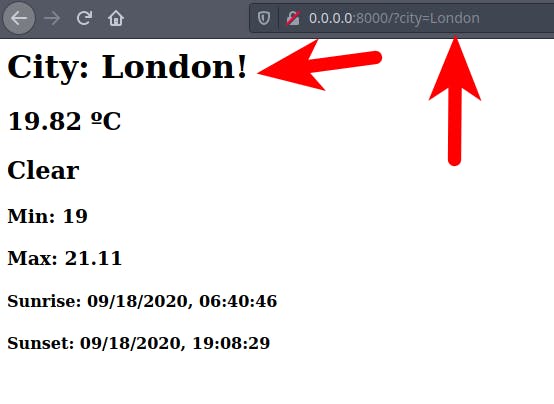单元测试可能令人生畏,但是这些 Python 模块会使你的生活变得更容易。

在这个教程中,你将学到如何对执行 HTTP 请求代码的进行单元测试。也就是说,你将看到用 Python 对 API 进行单元测试的艺术。
单元测试是指对单个行为的测试。在测试中,一个众所周知的经验法则就是隔离那些需要外部依赖的代码。
比如,当测试一段执行 HTTP 请求的代码时,建议在测试过程中,把真正的调用替换成一个假的的调用。这种情况下,每次运行测试的时候,就可以对它进行单元测试,而不需要执行一个真正的 HTTP 请求。
问题就是,怎样才能隔离这些代码?
这就是我希望在这篇博文中回答的问题!我不仅会向你展示如果去做,而且也会权衡不同方法之间的优点和缺点。
要求:
- Python 3.8
- pytest-mock
- requests
- flask
- responses
- VCR.py
使用一个天气状况 REST API 的演示程序
为了更好的解决这个问题,假设你正在创建一个天气状况的应用。这个应用使用第三方天气状况 REST API 来检索一个城市的天气信息。其中一个需求是生成一个简单的 HTML 页面,像下面这个图片:

伦敦的天气,OpenWeatherMap。图片是作者自己制作的。
为了获得天气的信息,必须得去某个地方找。幸运的是,通过 OpenWeatherMap的 REST API 服务,可以获得一切需要的信息。
好的,很棒,但是我该怎么用呢?
通过发送一个 GET请求到:
https://api.openweathermap.org/data/2.5/weather?q={city_name}&appid={api_key}&units=metric
检索数据
使用 requests模块来检索天气数据。你可以创建一个接收城市名字作为参数的函数,然后返回一个 JSON。JSON 包含温度、天气状况的描述、日出和日落时间等数据。
下面的例子演示了这样一个函数:
def find_weather_for(city: str) -> dict: """Queries the weather API and returns the weather data for a particular city.""" url = API.format(city_name=city, api_key=API_KEY) resp = requests.get(url) return resp.json这个 URL 是由两个全局变量构成:
BASE_URL = "https://api.openweathermap.org/data/2.5/weather"API = BASE_URL + "?q={city_name}&appid={api_key}&units=metric"API 以这个格式返回了一个 JSON:
{ "coord": { "lon": -0.13, "lat": 51.51 }, "weather": [ { "id": 800, "main": "Clear", "description": "clear sky", "icon": "01d" } ], "base": "stations", "main": { "temp": 16.53, "feels_like": 15.52, "temp_min": 15, "temp_max": 17.78, "pressure": 1023, "humidity": 72 }, "visibility": 10000, "wind": { "speed": 2.1, "deg": 40 }, "clouds": { "all": 0 }, "dt": 1600420164, "sys": { "type": 1, "id": 1414, "country": "GB", "sunrise": 1600407646, "sunset": 1600452509 }, "timezone": 3600, "id": 2643743, "name": "London", "cod": 200当调用 resp.json的时候,数据是以 Python 字典的形式返回的。为了封装所有细节,可以用dataclass来表示它们。这个类有一个工厂方法,可以获得这个字典并且返回一个WeatherInfo实例。
这种办法很好,因为可以保持这种表示方法的稳定。比如,如果 API 改变了 JSON 的结构,就可以在同一个地方(from_dict方法中)修改逻辑。其他代码不会受影响。你也可以从不同的源获得信息,然后把它们都整合到from_dict方法中。
@dataclassclass WeatherInfo: temp: float sunset: str sunrise: str temp_min: float temp_max: float desc: str @classmethod def from_dict(cls, data: dict) -> "WeatherInfo": return cls( temp=data["main"]["temp"], temp_min=data["main"]["temp_min"], temp_max=data["main"]["temp_max"], desc=data["weather"][0]["main"], sunset=format_date(data["sys"]["sunset"]), sunrise=format_date(data["sys"]["sunrise"]), )现在来创建一个叫做 retrieve_weather的函数。使用这个函数调用 API,然后返回一个WeatherInfo,这样就可创建你自己的 HTML 页面。
def retrieve_weather(city: str) -> WeatherInfo: """Finds the weather for a city and returns a WeatherInfo instance.""" data = find_weather_for(city) return WeatherInfo.from_dict(data)很好,我们的 app 现在有一些基础了。在继续之前,对这些函数进行单元测试。
1、使用 mock 测试 API
根据维基百科,模拟对象mock object是通过模仿真实对象来模拟它行为的一个对象。在 Python 中,你可以使用unittest.mock库来模拟mock任何对象,这个库是标准库中的一部分。为了测试retrieve_weather函数,可以模拟requests.get,然后返回静态数据。
pytest-mock
在这个教程中,会使用 pytest作为测试框架。通过插件,pytest库是非常具有扩展性的。为了完成我们的模拟目标,要用pytest-mock。这个插件抽象化了大量unittest.mock中的设置,也会让你的代码更简洁。如果你感兴趣的话,我在另一篇博文中会有更多的讨论。
好的,言归正传,现在看代码。
下面是一个 retrieve_weather函数的完整测试用例。这个测试使用了两个fixture:一个是由pytest-mock插件提供的mockerfixture, 还有一个是我们自己的。就是从之前请求中保存的静态数据。
@pytest.fixturedef fake_weather_info: """Fixture that returns a static weather data.""" with open("tests/resources/weather.json") as f: return json.load(f)def test_retrieve_weather_using_mocks(mocker, fake_weather_info): """Given a city name, test that a HTML report about the weather is generated correctly.""" # Creates a fake requests response object fake_resp = mocker.Mock # Mock the json method to return the static weather data fake_resp.json = mocker.Mock(return_value=fake_weather_info) # Mock the status code fake_resp.status_code = HTTPStatus.OK mocker.patch("weather_app.requests.get", return_value=fake_resp) weather_info = retrieve_weather(city="London") assert weather_info == WeatherInfo.from_dict(fake_weather_info)如果运行这个测试,会获得下面的输出:
============================= test session starts ==============================...[omitted]...tests/test_weather_app.py::test_retrieve_weather_using_mocks PASSED [100%]============================== 1 passed in 0.20s ===============================Process finished with exit code 0很好,测试通过了!但是...生活并非一帆风顺。这个测试有优点,也有缺点。现在来看一下。
优点
好的,有一个之前讨论过的优点就是,通过模拟 API 的返回值,测试变得简单了。将通信和 API 隔离,这样测试就可以预测了。这样总会返回你需要的东西。
缺点
对于缺点,问题就是,如果不再想用 requests了,并且决定回到标准库的urllib,怎么办。每次改变find_weather_for的代码,都得去适配测试。好的测试是,当你修改代码实现的时候,测试时不需要改变的。所以,通过模拟,你最终把测试和实现耦合在了一起。
而且,另一个不好的方面是你需要在调用函数之前进行大量设置——至少是三行代码。
... # Creates a fake requests response object fake_resp = mocker.Mock # Mock the json method to return the static weather data fake_resp.json = mocker.Mock(return_value=fake_weather_info) # Mock the status code fake_resp.status_code = HTTPStatus.OK...我可以做的更好吗?
是的,请继续看。我现在看看怎么改进一点。
使用 responses
用 mocker功能模拟requests有点问题,就是有很多设置。避免这个问题的一个好办法就是使用一个库,可以拦截requests调用并且给它们 打补丁patch。有不止一个库可以做这件事,但是对我来说最简单的是responses。我们来看一下怎么用,并且替换mock。
@responses.activatedef test_retrieve_weather_using_responses(fake_weather_info): """Given a city name, test that a HTML report about the weather is generated correctly.""" api_uri = API.format(city_name="London", api_key=API_KEY) responses.add(responses.GET, api_uri, json=fake_weather_info, status=HTTPStatus.OK) weather_info = retrieve_weather(city="London") assert weather_info == WeatherInfo.from_dict(fake_weather_info)这个函数再次使用了我们的 fake_weather_infofixture。
然后运行测试:
============================= test session starts ==============================...tests/test_weather_app.py::test_retrieve_weather_using_responses PASSED [100%]============================== 1 passed in 0.19s ===============================非常好!测试也通过了。但是...并不是那么棒。
优点
使用诸如 responses这样的库,好的方面就是不需要再给requests打补丁patch。通过将这层抽象交给库,可以减少一些设置。然而,如果你没注意到的话,还是有一些问题。
缺点
和 unittest.mock很像,测试和实现再一次耦合了。如果替换requests,测试就不能用了。
2、使用适配器测试 API
如果用模拟让测试耦合了,我能做什么?
设想下面的场景:假如说你不能再用 requests了,而且必须要用urllib替换,因为这是 Python 自带的。不仅仅是这样,你了解了不要把测试代码和实现耦合,并且你想今后都避免这种情况。你想替换urllib,也不想重写测试了。
事实证明,你可以抽象出执行 GET请求的代码。
真的吗?怎么做?
可以使用适配器adapter来抽象它。适配器是一种用来封装其他类的接口,并作为新接口暴露出来的一种设计模式。用这种方式,就可以修改适配器而不需要修改代码了。比如,在 find_weather_for函数中,封装关于requests的所有细节,然后把这部分暴露给只接受 URL 的函数。
所以,这个:
def find_weather_for(city: str) -> dict: """Queries the weather API and returns the weather data for a particular city.""" url = API.format(city_name=city, api_key=API_KEY) resp = requests.get(url) return resp.json变成这样:
def find_weather_for(city: str) -> dict: """Queries the weather API and returns the weather data for a particular city.""" url = API.format(city_name=city, api_key=API_KEY) return adapter(url)然后适配器变成这样:
def requests_adapter(url: str) -> dict: resp = requests.get(url) return resp.json现在到了重构 retrieve_weather函数的时候:
def retrieve_weather(city: str) -> WeatherInfo: """Finds the weather for a city and returns a WeatherInfo instance.""" data = find_weather_for(city, adapter=requests_adapter) return WeatherInfo.from_dict(data)所以,如果你决定改为使用 urllib的实现,只要换一下适配器:
def urllib_adapter(url: str) -> dict: """An adapter that encapsulates urllib.urlopen""" with urllib.request.urlopen(url) as response: resp = response.read return json.loads(resp)def retrieve_weather(city: str) -> WeatherInfo: """Finds the weather for a city and returns a WeatherInfo instance.""" data = find_weather_for(city, adapter=urllib_adapter) return WeatherInfo.from_dict(data)好的,那测试怎么做?
为了测试 retrieve_weather, 只要创建一个在测试过程中使用的假的适配器:
@responses.activatedef test_retrieve_weather_using_adapter( fake_weather_info,): def fake_adapter(url: str): return fake_weather_info weather_info = retrieve_weather(city="London", adapter=fake_adapter) assert weather_info == WeatherInfo.from_dict(fake_weather_info)如果运行测试,会获得:
============================= test session starts ==============================tests/test_weather_app.py::test_retrieve_weather_using_adapter PASSED [100%]============================== 1 passed in 0.22s ===============================优点
这个方法的优点是可以成功将测试和实现解耦。使用依赖注入dependency injection在测试期间注入一个假的适配器。你也可以在任何时候更换适配器,包括在运行时。这些事情都不会改变任何行为。
缺点
缺点就是,因为你在测试中用了假的适配器,如果在实现中往适配器中引入了一个 bug,测试的时候就不会发现。比如说,往 requests传入了一个有问题的参数,像这样:
def requests_adapter(url: str) -> dict: resp = requests.get(url, headers=在生产环境中,适配器会有问题,而且单元测试没办法发现。但是事实是,之前的方法也会有同样的问题。这就是为什么不仅要单元测试,并且总是要集成测试。也就是说,要考虑另一个选项。
3、使用 VCR.py 测试 API
现在终于到了讨论我们最后一个选项了。诚实地说,我也是最近才发现这个。我用模拟mock也很长时间了,而且总是有一些问题。VCR.py是一个库,它可以简化很多 HTTP 请求的测试。
它的工作原理是将第一次运行测试的 HTTP 交互记录为一个 YAML 文件,叫做 cassette。请求和响应都会被序列化。当第二次运行测试的时候,VCT.py将拦截对请求的调用,并且返回一个响应。
现在看一下下面如何使用 VCR.py测试retrieve_weather:
@vcr.use_cassettedef test_retrieve_weather_using_vcr(fake_weather_info): weather_info = retrieve_weather(city="London") assert weather_info == WeatherInfo.from_dict(fake_weather_info)天呐,就这样?没有设置?@vcr.use_cassette是什么?
是的,就这样!没有设置,只要一个 pytest标注告诉 VCR 去拦截调用,然后保存 cassette 文件。
cassette 文件是什么样?
好问题。这个文件里有很多东西。这是因为 VCR 保存了交互中的所有细节。
interactions:- request: body: null headers: Accept: - '*/*' Accept-Encoding: - gzip, deflate Connection: - keep-alive User-Agent: - python-requests/2.24.0 method: GET uri: https://api.openweathermap.org/data/2.5/weather?q=London&appid=确实很多!
真的!好的方面就是你不需要留意它。VCR.py会为你安排好一切。
优点
现在看一下优点,我可以至少列出五个:
- 没有设置代码。
- 测试仍然是分离的,所以很快。
- 测试是确定的。
- 如果你改了请求,比如说用了错误的 header,测试会失败。
- 没有与代码实现耦合,所以你可以换适配器,而且测试会通过。唯一有关系的东西就是请求必须是一样的。
缺点
再与模拟相比较,除了避免了错误,还是有一些问题。
如果 API 提供者出于某种原因修改了数据格式,测试仍然会通过。幸运的是,这种情况并不经常发生,而且在这种重大改变之前,API 提供者通常会给他们的 API 提供不同版本。
另一个需要考虑的事情是就地in place端到端end-to-end测试。每次服务器运行的时候,这些测试都会调用。顾名思义,这是一个范围更广、更慢的测试。它们会比单元测试覆盖更多。事实上,并不是每个项目都需要使用它们。所以,就我看来,VCR.py对于大多数人的需求来说都绰绰有余。
总结
就这么多了。我希望今天你了解了一些有用的东西。测试 API 客户端应用可能会有点吓人。然而,当武装了合适的工具和知识,你就可以驯服这个野兽。
在 我的 Github上可以找到这个完整的应用。
这篇文章最早发表在 作者的个人博客,授权转载
via: https://opensource.com/article/21/9/unit-test-python
作者:Miguel Brito选题:lujun9972译者:Yufei-Yan校对:wxy
本文由 LCTT原创编译,Linux中国荣誉推出
 鲁公网安备37020202000738号
鲁公网安备37020202000738号